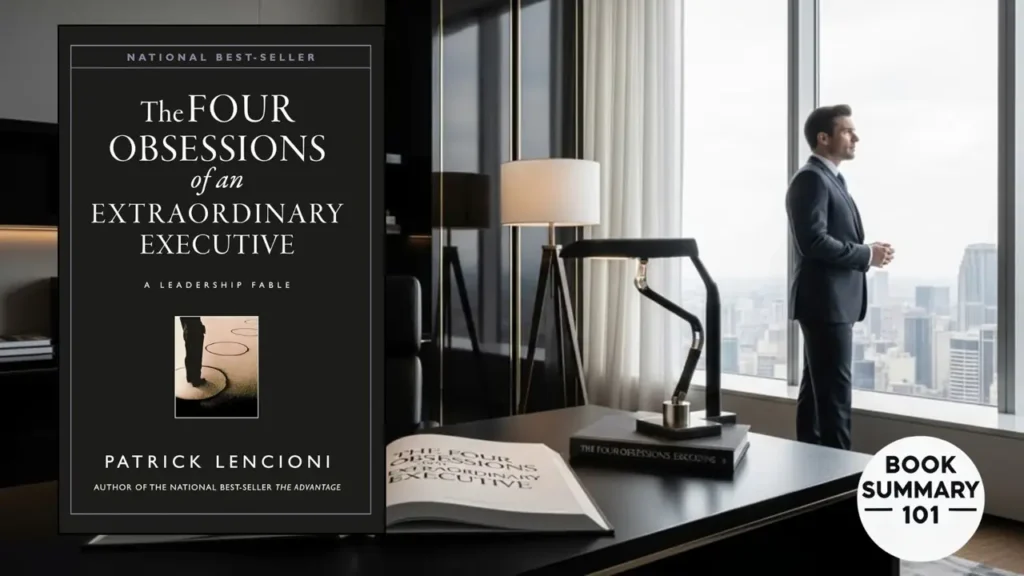Have you ever wondered what sets extraordinary leaders apart from the rest? Why do some companies thrive under one person’s guidance, while others seem to stumble despite having every resource in place? The Four Obsessions of an Extraordinary Executive by Patrick Lencioni dives into the answers, offering a compelling, story-driven exploration of what makes great leaders tick.
If you’re leading a team, aspiring to take on more responsibility, or simply looking to understand leadership at a deeper level, this book offers real, actionable insights. Let’s break down the main takeaways in a relatable, story-centric way.
Why Read This Book?
Whether you’re a seasoned executive or an emerging leader, The Four Obsessions of an Extraordinary Executive offers valuable, practical lessons that can transform the way you lead. The insights in this book are especially relevant today, as organizations increasingly focus on culture and clarity to succeed in competitive markets. Lencioni doesn’t just preach ideas—he gives us a practical roadmap for achieving greatness as a leader.
The Story: A Leadership Fable with a Twist
Lencioni’s approach is unique because he teaches through storytelling. The book centers around two rival CEOs: Rich O’Connor, the head of a successful but humble consulting firm, and his ambitious competitor, Vince Green. The plot revolves around the very different ways they run their companies, with Rich’s four “obsessions” ultimately proving to be the secret to his lasting success.
As we go through the story, it’s clear that these “obsessions” aren’t just random tactics. Instead, they’re deep-rooted principles that allow Rich’s company to excel in areas like employee loyalty, efficiency, and customer satisfaction, despite the competition.
Let’s unpack these four obsessions.
The Four Obsessions Explained
Sure! Here’s a deeper dive into each of the Four Obsessions. This should help readers connect more with the material and feel inspired to apply these principles in their own teams and organizations.
1. Build and Maintain a Cohesive Leadership Team
The foundation of any strong organization is a leadership team that operates like a well-oiled machine. But here’s the twist: it’s not enough to gather a group of talented people and hope they work well together. A cohesive team isn’t just skilled; it’s bonded by trust, aligned in purpose, and willing to hold each other accountable.
In the book, Rich O’Connor spends a lot of time ensuring that his leadership team truly trusts one another. This trust is what allows them to engage in healthy debate, challenge each other’s ideas, and make decisions that benefit the company as a whole. When people trust each other, they’re not afraid to speak up, admit mistakes, or call out issues, which leads to stronger, better-informed decisions.
Rich also emphasizes accountability within his leadership team. He ensures each team member has specific responsibilities and measures success not just by outcomes, but by how well they collaborate and contribute to the group.
- Real-Life Example: Think about the way Pixar operates. Leaders are selected for their ability to work together creatively and support each other’s ideas, rather than just for their individual skills. This is why Pixar’s leadership team has a reputation for being one of the best in the industry. Their ability to work as a cohesive unit allows them to keep pushing creative boundaries, because they trust one another enough to take risks.
2. Create Organizational Clarity
Once you have a solid leadership team, the next obsession is building clarity across the organization. Patrick Lencioni explains that this isn’t just about setting goals—it’s about creating an organization where everyone understands why they’re doing what they’re doing. A clear purpose, mission, and set of values are essential because they prevent confusion, siloed efforts, and competing priorities.
Rich knows that without clarity, his company could easily lose its way. He defines a clear purpose for the company, laying out what they stand for, why they’re in business, and what makes them different from their competitors. Every employee, from top leadership to new hires, understands these values and how they’re expected to contribute.
Rich also uses clarity to guide decisions and strategies across the company. When everyone understands the “big picture,” it becomes easier to align individual goals with the organization’s objectives. This clarity helps employees feel connected to something larger than their individual roles, which can be a powerful motivator.
- Real-Life Example: Zappos is an excellent example of a company that has mastered clarity. Known for its core values and unique culture, Zappos makes sure every employee understands and embodies their mission of “delivering WOW through service.” They hire, train, and reward employees based on their alignment with this mission, which creates a shared sense of purpose and direction across the organization.
3. Over-Communicate Organizational Clarity
Creating clarity is only the first step; communicating it is equally important—and more difficult than it might seem. Lencioni emphasizes that leaders should over-communicate the organization’s values, purpose, and mission to ensure everyone is on the same page. This means repeating key messages constantly, finding new ways to reinforce them, and making them a regular part of daily interactions.
Rich’s approach to over-communication involves bringing up the company’s mission and values in every meeting, email, and company event. He knows that people have short memories, and if leaders don’t consistently reinforce core messages, people will get distracted and lose sight of the big picture. When everyone from managers to frontline employees can articulate the company’s purpose, it leads to a stronger, more focused organization.
Regular communication also gives employees the chance to see how their work contributes to the larger goals of the company. It builds a sense of purpose and ownership because people know they’re working toward something meaningful. It’s not about overloading employees with information; it’s about keeping them connected to what truly matters.
- Real-Life Example: Amazon’s “customer obsession” principle is an example of over-communicated clarity. Amazon leaders are constantly reminding employees about their commitment to putting the customer first, from warehouse staff to executives. This principle is so deeply embedded that it shapes every decision and policy, making it clear to all employees that customer satisfaction is the top priority.
4. Reinforce Clarity Through Human Systems
The fourth obsession is about creating systems that reinforce the company’s values and clarity. If an organization’s culture is a building, then these systems are the structural beams. They keep everything in place, ensuring that employees’ day-to-day activities align with the organization’s core mission.
Rich doesn’t just rely on words to reinforce clarity; he designs systems and processes that support the company’s values at every level. This could mean implementing hiring practices that focus on cultural fit as much as on skills, creating onboarding programs that immerse new employees in the company’s mission, or designing feedback and reward systems that recognize alignment with core values.
When human systems reflect the company’s values, it creates a sense of consistency and purpose. People can see that the company is serious about its mission because they experience it in their everyday interactions. Rich’s leadership team is committed to making sure that every system, from training to performance evaluations, is aligned with the company’s values.
- Real-Life Example: Netflix has a famous “freedom and responsibility” culture. Their systems are designed to support this by giving employees a lot of autonomy but holding them accountable for results. This isn’t just an abstract value; it’s embedded in how they hire, promote, and evaluate people. Netflix’s systems create a strong sense of purpose and alignment, and employees are reminded daily of the value placed on responsibility and trust.
Real-Life Application: How to Bring These Lessons into Your Own Leadership
Ask yourself these questions:
- Do I have a cohesive leadership team that truly trusts each other, or are there lingering issues of ego or competition?
- Have I communicated our organization’s purpose, values, and mission in a way that everyone understands?
- Am I reinforcing these messages regularly, or have I assumed that people “just know”?
- Are my systems (hiring, training, rewards) aligned with the organization’s values?
Reflecting on these questions can help you identify areas to strengthen in your organization. Remember, the path to extraordinary leadership isn’t about adopting quick-fix strategies; it’s about committing to a mindset and a set of principles that shape everything you do.
Join the Conversation!
Have you read The Four Obsessions of an Extraordinary Executive? What’s your biggest takeaway, or how do you build trust and clarity in your own team? Let’s share insights, ideas, and tips on becoming better leaders. After all, extraordinary leadership is a journey, and we’re all learning together!
5 powerful quotes from The Four Obsessions of an Extraordinary Executive
📖 “No quality or characteristic is more important in building trust than a willingness to be vulnerable.”
- Meaning: Leaders who admit mistakes, share weaknesses, and ask for help create an environment of trust.
- Simple terms: Being real and open with your team makes them trust you more.
📖 “If everything is important, then nothing is.”
- Meaning: Without clarity on what truly matters, organizations spread themselves too thin and lose focus.
- Simple terms: You can’t prioritize everything—pick what matters most.
📖 “Clarity is not something you can create once and forget about; it must be constantly reinforced.”
- Meaning: Leaders need to repeat and reinforce the company’s vision and values over and over.
- Simple terms: People forget—so leaders must keep reminding them of the mission.
📖 “The ultimate measure of a great team is results.”
- Meaning: A cohesive leadership team isn’t about getting along—it’s about producing meaningful outcomes together.
- Simple terms: Team harmony matters, but results are what prove success.
📖 “Great organizations are not built by accident—they are built intentionally by leaders obsessed with discipline.”
- Meaning: Extraordinary leadership requires focus, consistency, and commitment to principles, not luck.
- Simple terms: Strong companies don’t just happen—they’re built with discipline and care.


